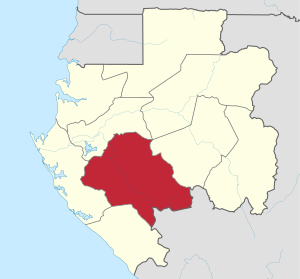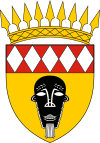Ngounié Province facts for kids
Quick facts for kids
Ngounié
|
|||
|---|---|---|---|
|
|||

Ngounié Province in Gabon
|
|||
| Country | |||
| Capital | Mouila | ||
| Area | |||
| • Total | 37,750 km2 (14,580 sq mi) | ||
| Population
(2013 census)
|
|||
| • Total | 100,838 | ||
| • Density | 2.6712/km2 (6.9184/sq mi) | ||
| HDI (2017) | 0.617 medium |
||
Ngounié is a province located in the south-central part of Gabon, a country in Africa. It's a big area, about 37,750 square kilometers! The main city and capital of Ngounié is Mouila. In 2013, about 100,838 people lived here. The province is named after the Ngounié River, which flows through it.
Contents
History of Ngounié
Long ago, in December 1858, a French explorer named Paul Du Chaillu traveled up the Ngounié River. He reached a place called Fougamou. During his trip, he met many local tribes and wrote about them in his travel journals.
Later, special Catholic missions were built in towns like Mandji, Sindara, and Saint Martin. These buildings have interesting designs that many tourists like to see.
Geography of Ngounié
The land in Ngounié is very diverse and beautiful. You can find large open areas called savannah and thick forests. In the north, there are mountains known as the Monts de Cristal. Further south, you'll find the Chaillu and Ikoundou mountain ranges.
The province has steep mountains next to flat plains and dense forests. There are also lakes and rich farmland, making the geography quite varied.
People of Ngounié
About 101,415 people live in Ngounié. The population is made up of many different ethnic groups. These include the Eshira, Apindjis, Punu, Tsogo, Nzebi, Massango, Vungu, and Eviya. These groups are all part of the larger Bantu family. They have lived together peacefully for many centuries.
Main Ethnic Groups
The largest ethnic groups in Ngounié include:
- The Punu and Eshira people.
- The Nzebi and Dyma people.
- The Okandé and Tsogho people.
- The Kota and Kélé people.
Traditional social and religious groups are still very important in daily life here. Two well-known ones are Bwiti and Ndjembé, which is a secret society for women.
Legends and Myths
Many popular legends say that the province of Ngounié is protected by special spirits. For example, there are stories about sirens named Ipeti and Mougoumi. Ipeti is said to live in Dola, and Mougoumi in Ngounié. People believe they protect the towns of Ndendé and Mouila.
Another legend tells of Tsamba, a male spirit, and Magotsi, a female spirit. They are said to protect Fougamou from the top of the Empress Eugenie Falls. These spirits are seen as symbolic protectors of the different parts of the province. People respect them and sometimes throw coins or pour drinks into the rivers to honor them.
Borders and Neighbors
To the southeast, Ngounié shares a border with the Niari Region of the Republic of the Congo.
Inside Gabon, Ngounié borders these other provinces:
- Nyanga to the south.
- Ogooué-Maritime to the west.
- Moyen-Ogooué to the north.
- Ogooué-Ivindo to the northeast, where four provinces meet at one point.
- Ogooué-Lolo to the east.
Departments of Ngounié
Ngounié is divided into 9 smaller areas called departments. Each department has its own main town:
- Boumi-Louetsi Department (main town: Mbigou)
- Dola Department (main town: Ndendé)
- Douya-Onoy Department (main town: Mouila)
- Louetsi-Wano Department (main town: Lébamba)
- Ndolou Department (main town: Mandji)
- Ogoulou Department (main town: Mimongo)
- Tsamba-Magotsi Department (main town: Fougamou)
- Louetsi-Bibaka Department (main town: Malinga)
- Mougalaba Department (main town: Guietsou)
See also
 In Spanish: Provincia de Ngounié para niños
In Spanish: Provincia de Ngounié para niños



